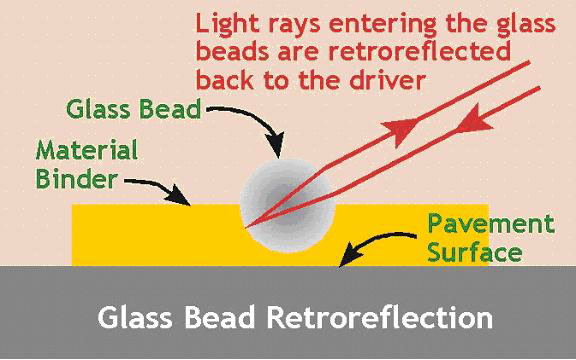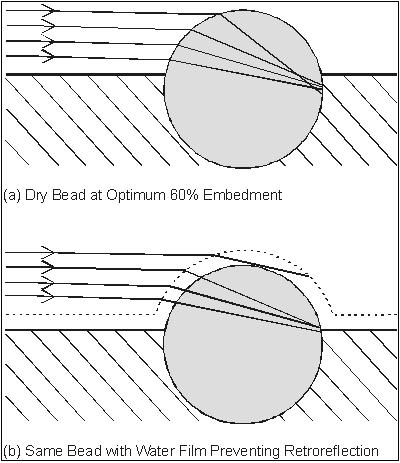Section 5: Glass Beads
Anchor: #i1021589Introduction
Pavement-marking retroreflectorization is accomplished through the use of glass beads partially embedded on the surface of the marking binder material. Glass beads play the most important role in pavement-marking retroreflectivity. Markings without beads are virtually useless at night. The bead returns light from a headlamp back to a driver, as shown in Figure 2-17.
Figure 2-17. 2-17. Pavement-marking retroreflectivity using glass beads.
Anchor: #i1021609Bead Types
TxDOT requires that beads be manufactured to conform to DMS-8290. Three types of bead gradations are specified under DMS 8290 and are tested using Tex-831-B. Type I beads are the smallest of the three types and are used only as intermix beads for thermoplastic. Type II beads are commonly referred to as “Texas standard” beads because they have historically been the typical drop-on beads used by TxDOT for many years. Type III beads are drop-on beads of a larger gradation. Type III beads are relatively new to the market and are marketed for their ability to provide wet-night visibility under certain conditions. Check with TxDOT’s Materials Laboratory for approved use of each bead type.
Anchor: #i1021622Bead Coatings
With some types of beads and marking materials, optimal bead application is difficult to achieve. Bead coatings are available that assist applicators in achieving proper bead embedment depths. Because Type III beads are more difficult to properly embed than Type II beads, Type III beads are coated with an adhesion or floatation coating prior to application. Type II beads are usually not coated. Adhesion coating is inspected according to Test Method Tex-833-B. Check with the glass bead manufacturer or TxDOT Materials Laboratory for current bead coating information.
Anchor: #i1021634Bead Application Properties
Bead application properties are controlled during striping through adjustments made by the applicator in the field. The two most important field-controlled properties are the amount and dispersion of exposed beads across a line and the depth of embedment of the beads. These properties are influenced by such characteristics as: bead drop rate, speed of the striping truck, temperature, and viscosity of the binder material, etc. Beads must be applied according to TxDOT specifications. Bead drop rates usually range from 6 to 12 pounds per 100 square feet for thermoplastics and are often higher for paints and epoxies. For details see “Glass Bead Application Properties” in Chapter 3, Section 4.
Anchor: #i1021646Bead Manufacturing-Controlled Properties
Bead properties that are controlled during the manufacturing process include those that are chemical and physical in nature. The chemical and physical properties of beads have a major influence on how well the beads reflect light. These properties include:
- bead size
- refractive index
- clarity
- roundness.
For beads to be used on TxDOT roadways, these properties must be in conformance with DMS-8290. These properties are controlled by manufacturing factors, such as: type, quality, and clarity of the glass; furnace type and temperature; and sieve size.
Discussions of each of these manufacturing-controlled properties follow under separate subheadings.
Anchor: #i1021688Bead Size
The size of a glass bead can affect retroreflectivity, especially under wet conditions. Larger beads (Type III) have slightly higher retroreflectivity than standard beads (Type II) under dry conditions. Bead size is influenced by the size of the raw materials sent into the furnace. Note that bead size has no effect on refractive index. Bead size is determined in the lab using Tex-831-B.
When markings are wet, beads are often rendered useless because the film of water that covers the marking causes light to scatter before it can enter the bead. This causes the wet markings to be nearly invisible at night. Large beads may be more effective when roads are slightly wet because their higher profile protrudes through the film of water better than small beads. Note that as the thickness of the water film increases, large beads begin to lose their effectiveness as well. Figure 2-18 shows light refracting through a dry glass bead versus the same glass bead with a film of water covering it.
Figure 2-18. Light refraction for dry glass bead vs. glass bead covered with water film.
Anchor: #i1021715Refractive Index
The refractive index (RI) is a function of the chemical makeup of the beads, which is determined by the raw material used to make the bead. The higher the refractive index, the more light is retroreflected. Refractive index is tested by using Test Method Tex-822-B.
Most beads used in roadway striping nationwide have a refractive index of 1.50. A bead with a 1.50 refractive index is made from recycled windowpane glass. Beads with higher refractive indices, including 1.65 and 1.90, are made from virgin glass and have a different chemical makeup. Higher refractive index beads are not frequently used because they are more expensive and may be slightly less durable than 1.50 RI beads. Some agencies use a blend of higher and lower refractive index beads.
Anchor: #i1021732Clarity and Roundness
Clarity and roundness are the two essential properties that all beads must possess to retroreflect light. The need for transparency and roundness can be explained by examining the path of light as it enters a bead embedded in a marking. The glass bead must be transparent so that light passes through the sphere. Clarity is strongly affected by the type of raw material used. Beads that are less than transparent block a portion of the light from entering.
The rounded surface of the bead causes the light ray to bend downward to a point below where the bead is embedded in the paint. Light striking the back of the embedded portion of the bead is reflected back to the path of entry. Roundness is greatly influenced by the properties of the blast furnace. Beads that are less than perfectly round have diminished retroreflective properties. Roundness is tested in the lab by Test Method Tex-832-B.

